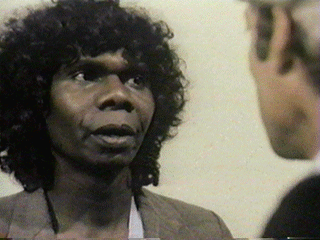The Tracker DVD has a one-hour documentary on Gulpilil called One Red Blood. It's well worth watching.
Gulpilil: One Red Blood
The film finds Gulpilil on the set of The Trackers where he plays a lead role, and then follows him back to his community where his tribal status and relative affluence leads to social, obligations. This documentary is about how Gulpilil moves between these two very different worlds.
Gulpilil was born in 1953 and grew-up on an Aboriginal reserve. He went to work as a stockman like most boys of his generation, however he showed exceptional talents as a dancer. In 1969, when he was only 14, he was chosen by English director Nicholas Roeg to play the lead in the film Walkabout. Walkabout soon became a cult classic and Gulpilil quickly gained parts in a succession of films including Mad Dog Morgan (1976), Storm Boy (1976), The Last Wave (1977) and Crocodile Dundee (1986). Gulpilil also led a traditional dance troop for 10 years and staged performances around the country including the Sydney Opera House.
Since the mid-1980's Gulpilil career declined, however he has gone through a recent resurgence with his roles in Rabbit-Proof Fence and The Tracker. In the documentary we hear from some of the directors who have worked with him and from colleagues like actor Justine Saunders, activist Gary Foley, the actor Jack Thompson as well as two of his former wives.
It's tempting to think of Gulpilil as an Australian Sidney Poitier. Just three years before his appearance in Nicholas Roeg's 1971 "Walkabout," white actors were still appearing in blackface to play aboriginal characters in Australian films.
Even more fascinating than his movie career, however, is his everyday life in the village of Ramingining in Northern Australia. He and his extended family continue to live in a makeshift house on the banks of a crocodile-infested river, where gathering fresh water and hunting for food are the order of the day.
Pic is assembled in "This Is Your Life"-style (including, ironically, a clip from Gulpilil's long-ago appearance on that very program), alternating film clips and archival footage of Gulpilil with interviews with friends, colleagues and admirers. Yet, Johnson's film is not all valedictory tribute; though made with Gulpilil's full cooperation (he even shares the "film by" credit in pic's opening titles), pic doesn't back away from depicting Gulpilil's dalliances with drugs and alcohol or his temporary inability to find work following the success of "Crocodile Dundee."
Johnson's film never loses sight of its social concerns. Despite Gulpilil's enormous personal success, there's an undercurrent running throughout "One Red Blood"--one that leaves the viewer with a strong sense of just how much remains to be accomplished regarding the peaceful co-existence of white and aboriginal cultures.
Comment: Among the things you'll learn from watching this documentary:
1) How indigenous actors are undervalued.
Gulpilil received only $10,000 for his work in Crocodile Dundee. According to IMDB.com, this was his 13th movie or TV role and he was billed fourth in Crocodile Dundee.
2) How indigenous actors face logistical problems.
When someone in the US contacted Gulpilil about filming him--for a commercial, I think--it required a two-day trek. Gulpilil had to retrieve his passport, which meant swimming across a crocodile-infested river and walking to his village in northwestern Australia. Then came the actual travel: flying across Australia and then across the ocean to America.
This hints at the difficulty of using authentic Natives in movies. If you wanted a traditional Navajo who knew the language and customs, it might take almost as long to transport him to Hollywood.
3) How indigenous actors add authenticity.
As in The Tracker, Gulpilil plays, well, a tracker in Rabbit-Proof Fence. In that film, he pursues three runaway girls across the Outback.
In Rolf de Heer's original screenplay for Rabbit-Proof Fence, the tracker couldn't catch them. Gulpilil noted that this was unrealistic; no inexperienced children could elude an experienced tracker.
Because of Gulpilil's input, de Heer changed the script. When the tracker found signs of the girls’ flight, he smiled slightly to himself. This seemingly minor gesture signaled a huge shift in the tracker's role. Now he knew the girls' whereabouts but was intentionally letting them go.
This adds an extra layer to Rabbit-Proof Fence--a small but notable improvement. Rather than working solely for "the man," the tracker is acting as a double agent. He pretends to help the Anglos while actually thwarting them.
That might be enough to add an extra half a point to my rating for Rabbit-Proof Fence. It might be enough to boost the positive reviews and box-office receipts by 5% too. It's an example of how authentic casting can have a tangible effect on a movie's quality.
For more on the subject, see The Best Indian Movies.


2 comments:
My family and I just watched "Storm Boy" 1976 with David Gulpilil in it and we were woefully ignorant of him. So we looked up the internet and were saddened to see how badly he was treated in our country.There is such a divide in our country still between black and white. It is hard to bridge as people on both sides are biaised against each other.What can be done? I dont know. Even though I have been to Uganda to preach the gospel of Jesus and saw many muslims convert to Jesus and I recently went to India and saw Hindus convert tyo Jesus...with the indigenous people of this country I was born in...the gospel has not succeeded , for which I am so sad about.
I don't think converting people to Christianity is the answer here or abroad. But thanks for your thoughts.
Post a Comment